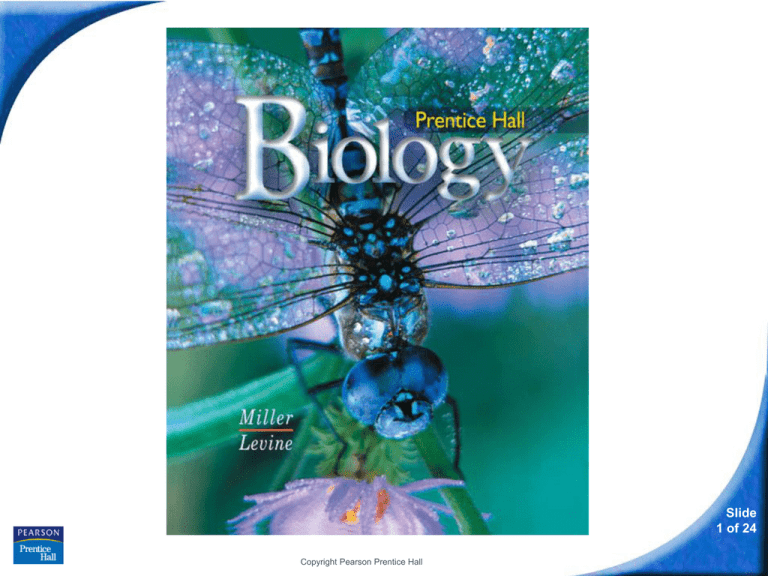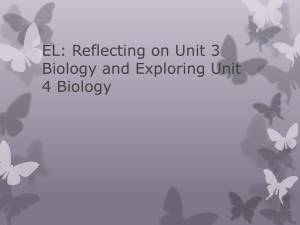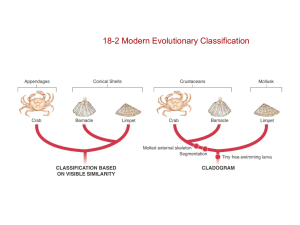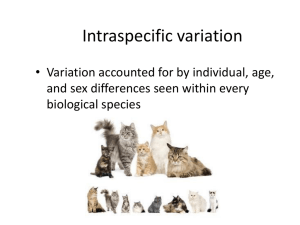
Biology
Slide
1 of 24
Copyright Pearson Prentice Hall
18-2 Modern Evolutionary
Classification
Slide
2 of 24
Copyright Pearson Prentice Hall
18-2 Modern Evolutionary Classification
Evolutionary
Classification
Which Similarities Are Most Important?
Linnaeus grouped species into larger taxa
mainly according to visible similarities and
differences.
How are evolutionary relationships
important in classification?
Slide
3 of 24
Copyright Pearson Prentice Hall
18-2 Modern Evolutionary Classification
Evolutionary
Classification
Evolutionary Classification
Phylogeny is the study of evolutionary
relationships among organisms.
Slide
4 of 24
Copyright Pearson Prentice Hall
18-2 Modern Evolutionary Classification
Evolutionary
Classification
Biologists currently group organisms into
categories that represent lines of
evolutionary descent, or phylogeny, not
just physical similarities.
The strategy of grouping organisms is based
on evolutionary history and is called
evolutionary classification.
Slide
5 of 24
Copyright Pearson Prentice Hall
18-2 Modern Evolutionary Classification
Evolutionary
Classification
The higher the level of the taxon, the further back in
time is the common ancestor of all the organisms in
the taxon.
Organisms that appear very similar may not share a
recent common ancestor.
Slide
6 of 24
Copyright Pearson Prentice Hall
18-2 Modern Evolutionary Classification
Evolutionary
Classification
Different Methods of Classification
Appendages
Crab
Barnacle
Mollusk
Crustaceans
Conical Shells
Limpet
Crab
Barnacle
Molted external
skeleton
Segmentation
CLASSIFICATION BASED ON
VISIBLE SIMILARITY
Limpet
Tiny freeswimming larva
CLADOGRAM
Slide
7 of 24
Copyright Pearson Prentice Hall
18-2 Modern Evolutionary Classification
Evolutionary
Classification
Superficial similarities once led barnacles and limpets
to be grouped together.
Appendages
Crab
Conical Shells
Barnacle
Limpet
Slide
8 of 24
Copyright Pearson Prentice Hall
18-2 Modern Evolutionary Classification
Evolutionary
Classification
However, barnacles and crabs share an evolutionary
ancestor that is more recent than the ancestor that
barnacles and limpets share.
Barnacles and crabs are classified as crustaceans,
and limpets are mollusks.
Slide
9 of 24
Copyright Pearson Prentice Hall
18-2 Modern Evolutionary Classification
Classification Using
Cladograms
Classification Using Cladograms
Many biologists now use a method called cladistic
analysis.
Cladistic analysis identifies and considers only new
characteristics that arise as lineages evolve.
Characteristics that appear in recent parts of a
lineage but not in its older members are called
derived characters.
Slide
10 of 24
Copyright Pearson Prentice Hall
18-2 Modern Evolutionary Classification
Classification Using
Cladograms
Derived characters can be used to construct a
cladogram, a diagram that shows the evolutionary
relationships among a group of organisms.
Cladograms help scientists understand how one
lineage branched from another in the course of
evolution.
Slide
11 of 24
Copyright Pearson Prentice Hall
18-2 Modern Evolutionary Classification
Classification Using
Cladograms
A cladogram shows the evolutionary relationships
between crabs, barnacles, and limpets.
Crustaceans
Mollusk
Barnacle
Crab
Limpet
Molted external skeleton
Segmentation
Tiny free-swimming larva
Slide
12 of 24
Copyright Pearson Prentice Hall
18-2 Modern Evolutionary Classification
Similarities in DNA
and RNA
Similarities in DNA and RNA
How can DNA and RNA help scientists
determine evolutionary relationships?
Slide
13 of 24
Copyright Pearson Prentice Hall
18-2 Modern Evolutionary Classification
Similarities in DNA
and RNA
The genes of many organisms show
important similarities at the molecular
level.
Similarities in DNA can be used to help
determine classification and evolutionary
relationships.
Slide
14 of 24
Copyright Pearson Prentice Hall
18-2 Modern Evolutionary Classification
Similarities in DNA
and RNA
DNA Evidence
DNA evidence shows evolutionary relationships of
species.
The more similar the DNA of two species, the more
recently they shared a common ancestor, and the
more closely they are related in evolutionary terms.
The more two species have diverged from each
other, the less similar their DNA will be.
Slide
15 of 24
Copyright Pearson Prentice Hall
18-2 Modern Evolutionary Classification
Molecular Clocks
Molecular Clocks
Comparisons of DNA are used to mark the
passage of evolutionary time.
A molecular clock uses DNA comparisons to
estimate the length of time that two species have
been evolving independently.
Slide
16 of 24
Copyright Pearson Prentice Hall
18-2 Modern Evolutionary Classification
Molecular Clocks
A gene in an
ancestral species
Molecular Clock
2 mutations
new
mutation
Species
A
2 mutations
new
new
mutation mutation
Species
B
Copyright Pearson Prentice Hall
Species
C
Slide
17 of 24
18-2 Modern Evolutionary Classification
Molecular Clocks
A molecular clock relies on mutations to mark time.
Simple mutations in DNA structure occur often.
Neutral mutations accumulate in different species at
about the same rate.
Comparing sequences in two species shows how
dissimilar the genes are, and shows when they
shared a common ancestor.
Slide
18 of 24
Copyright Pearson Prentice Hall
18-2
Click to Launch:
Continue to:
- or -
Slide
19 of 24
Copyright Pearson Prentice Hall
18-2
Grouping organisms together based on their
evolutionary history is called
a. evolutionary classification.
b. traditional classification.
c. cladogram classification.
d. taxonomic classification.
Slide
20 of 24
Copyright Pearson Prentice Hall
18-2
Traditional classification groups organisms
together based on
a. derived characters.
b. similarities in appearance.
c. DNA and RNA similarities.
d. molecular clocks.
Slide
21 of 24
Copyright Pearson Prentice Hall
18-2
In an evolutionary classification system, the
higher the taxon level,
a. the more similar the members of the taxon
become.
b. the more common ancestors would be found
in recent time.
c. the fewer the number of species in the taxon.
d. the farther back in time the common
ancestors would be.
Slide
22 of 24
Copyright Pearson Prentice Hall
18-2
Classifying organisms using a cladogram
depends on identifying
a. external and internal structural similarities.
b. new characteristics that have appeared most
recently as lineages evolve.
c. characteristics that have been present in the
group for the longest time.
d. individual variations within the group.
Slide
23 of 24
Copyright Pearson Prentice Hall
18-2
To compare traits of very different organisms,
you would use
a. anatomical similarities.
b. anatomical differences.
c. DNA and RNA.
d. proteins and carbohydrates.
Slide
24 of 24
Copyright Pearson Prentice Hall
END OF SECTION









